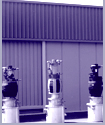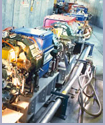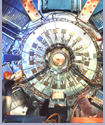SLAC Tours
Tours of SLAC will be given Friday, August 8th, at 2:45pm. Tours meet promptly at 2:45pm in the auditorium breezeway. Interested SSI participants will have the opportunity to sign up for the tours in the auditorium lobby.
| Klystron Gallery | |
|
Klystrons as far as the eye can see generate the microwaves which power the SLAC linac. A stop at the Visitor’s Gallery along the two mile accelerator, shows the critical linac components, explains their workings, and provides a spectacular visual experience. A “must-see” at SLAC. |
 |
| SSRL | |
|
The Stanford Synchrotron Radiation Laboratory, a division of Stanford Linear Accelerator Center, is operated by Stanford University for the Department of Energy. SSRL is a National User Facility which provides synchrotron radiation, for a wide variety of experiments. These extremely bright x-rays can be used to investigate various forms of matter ranging from objects of atomic and molecular size to man-made materials with unusual properties. The obtained information and knowledge obtained is of great value to society, with impact in areas such as the environment, future technologies, health, and national security. |
 |
| BABAR | |
| The B-Factory is SLAC's premier high energy physics program and is investigating the matter-antimatter asymmetry observed in nature. The BaBar detector consists of a silicon vertex detector, a drift chamber, a novel particle identification system called the DIRC, a Csl electromagnetic calorimeter, and a magnet with an instrumented flux return; it looks like an organized conglomeration of steel, crystals, and wires. |
 |
| KIPAC Labs on Stanford University | |
|
The Camera Materials Test Chamber, which will measure the outgassing and consequent light transmittance degradation properties of candidate materials for the LSST camera. You will also visit the metrology testing apparatus which can measure micron-level deviations from flatness in prototypes of the LSST focal plane mechanical design. EP Lab:Our aim is to use precision atom interferometry to test Einstein's Equivalence Principle (EP) with an accuracy of 15 digits by measuring the free-fall acceleration of individual atoms. To reach this record sensitivity, we have constructed a 10-meter tall vacuum chamber where we will drop ultracold atom clouds consisting of two isotopes of rubidium. The resulting free-fall times are up to 2.8 seconds long, allowing us to test for EP-violating differential accelerations between the isotopes as small as 10^-15 /g/. With such high precision, we can also use our apparatus to measure novel general relativistic effects that have never been observed in a laboratory environment, including the gravitational attraction of the atom's kinetic energy. |
|
| Visualization Lab at Fred Kavli Building | |
| Whether it is Terabytes of simulation output or experimental data, KIPAC researchers exploit modern visualization techniques to extract the maximum amount of information from their data. More often than not that means to write new tools at the cutting edge of scientific visualization. This work is done in the specially constructed Schwob Computing and Information Center. Read more... | |

